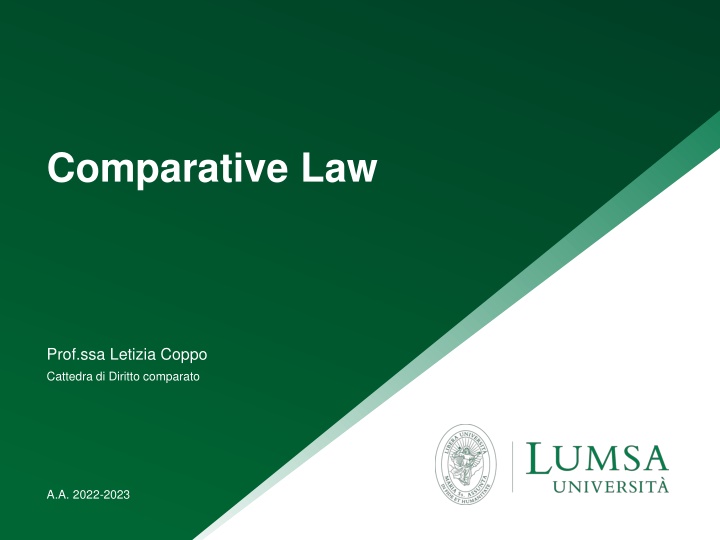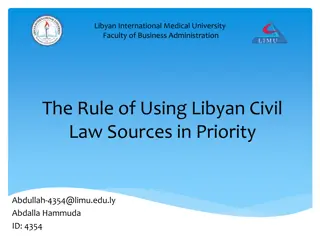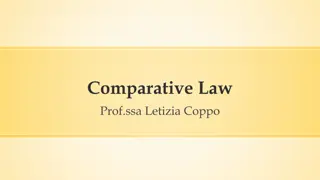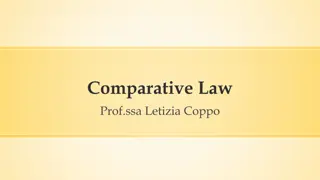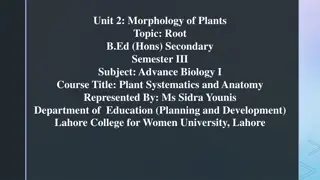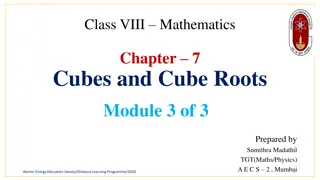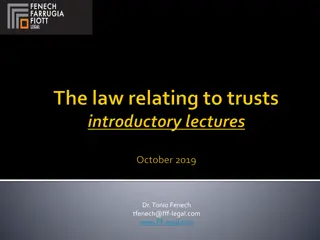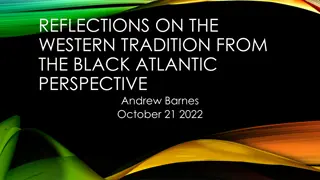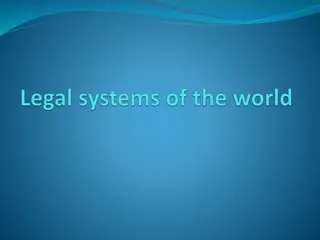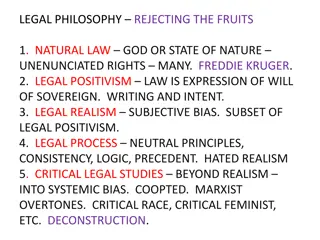Common Roots of Western Legal Tradition: Civil Law Evolution
Explore the evolution of civil law through the teaching of Roman law in universities, development of jus commune, Gregorian reform, and the divergence between Romanistic and Germanic legal families. Discover how the universities and scientia juris played a crucial role in shaping legal education and interpreting texts with authority in Medieval Europe.
Download Presentation

Please find below an Image/Link to download the presentation.
The content on the website is provided AS IS for your information and personal use only. It may not be sold, licensed, or shared on other websites without obtaining consent from the author.If you encounter any issues during the download, it is possible that the publisher has removed the file from their server.
You are allowed to download the files provided on this website for personal or commercial use, subject to the condition that they are used lawfully. All files are the property of their respective owners.
The content on the website is provided AS IS for your information and personal use only. It may not be sold, licensed, or shared on other websites without obtaining consent from the author.
E N D
Presentation Transcript
Comparative Law Prof.ssa Letizia Coppo Cattedra di Diritto comparato A.A. 2022-2023
THE COMMON ROOTS OF THE WESTERN LEGAL TRADITION The origins and the common background For civil law: the teaching of Roman law in the universities, the development of the scientia juris in the Middle Ages and its spread as jus commune; the Gregorian reform, jusnaturalism and jusrationalism. For common law: the Norman conquest of England in the Middle Ages; the hierarchical organisation of judicial and executive power; the bureaucratisation of the system and the feudal structure of society. 2 Universit LUMSA
The common roots of the civil law tradition And the subsequent divergence between the Romanistic and the Germanic legal family
CIVIL LAW: THE UNIVERSITIES & THE SCIENTIA JURIS Context Wide-spread need for order; social need to regulate human relationships with pre-determined procedures and rules rather than through the use of force. - Universities showed that it was possible to apply the set of rules coming from late Roman law even to the current conflict of interests raised by human relationships. - They could teach the ability to think in terms of institutional problems, conceive issues that had not been classified before in terms of logical mental ordering. Legal education become crucial. 4 Universit LUMSA
CIVIL LAW: THE UNIVERSITIES & THE SCIENTIA JURIS Context At that time Europe lacked unity and a centralised power, so nobody could establish a judicial system entitled to issue decisions and enforce them. Roman common law, as taught in the Universities and applied in courts, spread all over Europe and was maintained as a basically unitary tradition. All the different areas of Europe were also governed by local customs and statutes, but the great ordering categories provided by jus commune transformed original ideas siding them with a complex net of classification concepts. 5 Universit LUMSA
CIVIL LAW: THE UNIVERSITIES & THE SCIENTIA JURIS Jus dicere The concept jus dicere: it does not mean finding rules on the basis of wisdom and experience, but interpreting a text provided with its own authority. Key-skill: interpretation based on the intellectual and logical tools drawn by Medieval philosophy (which had been practiced a lot in the interpretation of the Bible). 6 Universit LUMSA
CIVIL LAW: THE UNIVERSITIES & THE SCIENTIA JURIS Consequences of the completeness of the system Jurists facing gap-less systems develop skills other than the ones needed by jurists facing complete systems. They do not need to find from time to time the best solutions, but they need to get a grasp of the whole system, to organise their mentality in a systematic way. They need a different interpretative tool box: glossae, summae, definitiones, distinctiones, quaestiones. 7 Universit LUMSA
CIVIL LAW: THE UNIVERSITIES & THE SCIENTIA JURIS Legacies: different conception of jus dicere Common law conceives judgments as turning into law what was not law; bending reality towards the law; judgments create law. Civil law judgments are conceived as a subsumption process, the fulfilment of the logical reasoning that is already contained in general provisions or in the principles on which the system is grounded; judgments do not create law, but apply the law. Interpretation was not reduced to mere syllogism, but was based on a plurality of criteria and also carried value-based judgements inspired by the idea of justice. Law is a science, but its reference is society, i.e. a magmatic, non scientific concept, in constant evolution. 8 Universit LUMSA
CIVIL LAW: THE INFLUENCE OF THE CHURCH The Gregorian Reform It provided the model of a complex organisation grounded on legal rules and procedures, with its ecclesiastical hierarchies, division of powers between the Pope and the bishops, legal status of the clergy, liturgical and administrative apparatus 9 Universit LUMSA
CIVIL LAW: THE INFLUENCE OF THE CHURCH The main legacies of canon law From a substantive viewpoint: defects of consent (very refined regime in canon law marriage); prohibition of usury; good faith and other values related to catholic morals. From a procedural viewpoint: Civil and criminal procedure rules: struggle for a legally based trial grounded on strict and predetermined legal rules. 10 Universit LUMSA
CIVIL LAW: THE INFLUENCE OF PHILOSOPHY Jusnaturalism and jusrationalism Jusnaturalism (XVII-XVII): a cosmopolitan ideal stream aimed at finding the ethical basis of legal rules. Jusrationalism: an ideal stream developed by Ugo Grozio, according to which legal rules are linked to the acknowledgement of the rationality inherent in human beings. Systematic study of the rules as a guarantee of their rational legitimacy; identification of the problems behind the single cases and identification of the rational basis of rules to assess them critically. 11 Universit LUMSA
CIVIL LAW: DIVERGENCE FROM THE COMMON ROOTS The Romanistic legal family French revolution: need to erase the past and build a new society; French style laicity; Napoleonic codification: unification of written law and customary law; codification of the main branches of the law (from 1804) and export of the code to Italy, Spain, Portugal..., but not to Germany; development of exegetic school (grammatical and logical study of the code) the judge as mouth of the law and of the school of the free scientifical research (interpretation of the code in light of the needs expressed by society). 12 Universit LUMSA
CIVIL LAW: DIVERGENCE FROM THE COMMON ROOTS The Germanic legal family Little impact of the French revolution: the Prussian state was strong and capable of offering a certain stability, that it was necessary to preserve. No codification until 1900: Germany has refused both the Prussian and the French model. Pandect school: (Windscheid, Puchta): purpose to schematize, systematize and supplement the concept of classical Roman law. Dogmatic study of Roman law without any room for practical reasons or value judgements or political or moral observations. 13 Universit LUMSA
CIVIL LAW: DIVERGENCE FROM THE COMMON ROOTS Main differences between the French cc and the BGB Code Napol on Code civil allemand (BGB) Civil code of the French Fundamental law of the German federation Bourgeois code, product of the French revolution, even if it rested on a large number of traditional institutions like freedom of contract and property. The BGB was promulgated in a time of social and political stability, so its spirit was rather retrospective, reflexive and conservative; it mirrored the social model of Bismarck empire as a liberal bourgeois that had built the German nation by cooperating authoritarianism. Blind to social movements. with Prussian Simple and transparent drafting style, capable of making concepts intelligible also to non jurists. Influence of the exegetic school. The BGB was not addressed to citizens but to lawyers; it had no ambition to educate its non-jurist readers. Accuracy of thought, clarity, exhaustivity, but a complex syntax and sometimes a gothic style. The BGB was the calculating machine par Pandects. excellence. Influence of 14 Universit LUMSA
CIVIL LAW: DIVERGENCE FROM THE COMMON ROOTS French jurists v. German jurists French jurists German jurists The best representative of the French legal system is the barrister, with the brilliant rhetoric of his pleadings, his prestige and his being the symbol of that French gentry who was triumphant with the revolution. The best representative of the German legal system is the professor. Even the ideal German lawyer is the one of a learned scholar with a PhD; the legal battles are not won in courtrooms our parliaments but in books. German lawyers are apolitical; their ideal qualities are accuracy, learnedness, a strong tendency to engage in academic disputes and to conceptualise everything in order to master legal reality. French lawyers use in principle a less technical vocabulary and are closely linked, from a historical viewpoint, to politics. They used to seat both in courts and parliaments and to fight for the citizens freedom against the Theatrical style, clarity, syntheticism, eloquence: la forme donne l tre la chose . public administration. 15 Universit LUMSA
The roots of the common law tradition The roots of English common law
COMMON LAW: THE MEDIEVAL PERIOD The Norman conquest 1066 a.D. Battle of Hastings and Norman conquest of England. Construction of a well-organised feudal system, where land belong to the king and was awarded to subjects as a tenancy. Political context: strong central royal authority; net of permanent administrative officers; centralised judicial system, with its own procedural rules. 17 Universit LUMSA
COMMON LAW: THE MEDIEVAL PERIOD The organisation of the judiciary (1300-XVII century) 1) Curia Regis or Exchequer: supreme treasury and jurisdiction for tax litigation. 2) Court of Common Pleas: jurisdiction over disputes between individuals; power to supervise lower courts run by sheriffs. 3) significance. Court of Bench: matters of political King s 18 Universit LUMSA
COMMON LAW: THE MEDIEVAL PERIOD The procedural system Procedural rules of royal courts were more modern and progressive, as based on forms of action made available by the royal administration (more authority and prestige). Local significance. rules applied by Anglo-Saxon tribes lost A formal system of claims developed, which was unconsciously close to ancient Roman trial structure. 19 Universit LUMSA
COMMON LAW: THE MEDIEVAL PERIOD The procedural system: the writs In common language they were letters from a superior, whether ecclesiastical or law, containing a message for the addressee with a request or an instruction. In legal language they were commands of the king directed to the competent officials, judges or magistrates, containing a brief description of the matter under dispute and instructing the addressee to call the defendant into court and solve the conflict before the parties. 20 Universit LUMSA
COMMON LAW: THE MEDIEVAL PERIOD The procedural system: the writs 21 Universit LUMSA
COMMON LAW: THE MEDIEVAL PERIOD The procedural system: the writs Writ of right: it enabled a vassal to demand that defendant refrains from interfering with his right to possess and use a piece of land. Writ of customs and services: it enabled the landlord to claim from the vassal that he performed his services. Writ of replevin: claim that the superior releases the chattels on which he has distrained in order to exact the feudal services. 22 Universit LUMSA
COMMON LAW: THE MEDIEVAL PERIOD The procedural system: the writs Main features of writs They were typical and begun to be standardised, but with a strong evolutionary potential (see writ of trespass). Each matched with certain facts and a certain claim and had its own procedural rules; a miss-match meant the denial of the claim. 23 Universit LUMSA
COMMON LAW: THE MEDIEVAL PERIOD Common law and equity The formalism of Common Law trials was excessive, so parties who lost a lawsuit in the King s Courts or could not obtain a writ, started addressing their petitions to the King in person. Gradually, such petitions were committed to the King s Chancellor, a churchman: his decisions developed into what is known as Equity Common law and Equity start being separate and potentially conflicting concepts, though they are not perceived by English jurists as antithetical. They were more perceived one (common law) as the text, or the code, the other as the supplement. 24 Universit LUMSA
Prof.ssa Letizia Coppo Email: l.coppo1@lumsa.it lcoppo@univ-catholyon.fr
